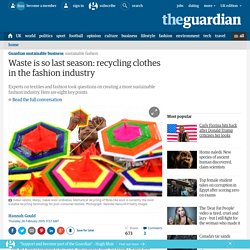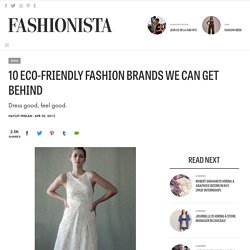

Mobile Site Preview. H&M DoSomething Comeback Clothes Campaign - Recycle Your Clothes. DoSomething.org Advertisement - Continue Reading Below Now's the time to do something good with that old ripped tee you've been holding onto!

You know the one. It's been hanging in the back of your closet for, oh, ever. DoSomething.org, one of the largest and most amazing organizations for young people and social change, and H&M have teamed up to launch a campaign to encourage you to recycle your old clothes, called Comeback Clothes. Get all your friends together and make it a big recycling party! Will you be participating in the Comeback Clothes campaign? H&M Makes Recycling Look Pretty Badass In New Campaign. Waste is so last season: recycling clothes in the fashion industry. So, which textiles can be recycled and how?

“The key differentiation is between ‘mechanical fibre recycling’, which will degrade with each recycling (down-cycling) and ‘chemical fibre recycling’ which in some cases can produce fibres of equal quality to virgin ones” explains senior research fellow, Textiles Environment Design, Kate Goldsworthy. Mechanical recycling of natural fibres like cotton and wool is currently the most scalable recycling technology for post-consumer textiles but the result is shorter textile fibres of a lower quality to virgin fibres, adds Carola Tembe, H&M’s environmental sustainability co-ordinator. To increase quality, recycled fibres must be blended with virgin fibres. When it comes to chemical recycling, only polyester and certain nylons can currently be reprocessed. However, new technologies are being developed and cotton could be up next.
What sort of by-products are created when textiles are recycled? What’s the hold up? 10 Eco-Friendly Fashion Brands We Can Get Behind - Fashionista. Nowadays in fashion, the words "eco-friendly," "organic" and "sustainable" get bandied around a lot.

Which is a good thing. Except that sometimes it can be hard to tell the difference between a brand that's actually helping to make the planet a better place--and one that's just riding the eco bandwagon with a less-than-well intentioned "organic" label. "Yes [companies are cashing in on consumers' growing environmental awareness by labeling their clothes "green," without actually changing their production process too much]," Timo Rissanen, Parsons' Assistant Professor of Fashion Design and Sustainability, told me. "The industry on the whole and marketing in particular have little integrity. " "'Green', 'eco', 'sustainable' and the rest are nice but meaningless, feel-good marketing terms," he added.
Part of the reason why it's so hard to put your finger on what a brand is actually doing to help the planet is because for many of the "eco" terms, there's no one definition. Study NY Feral Childe. A Brief History of Sustainable Fashion. Type the words ‘future’ and ‘fashion’ into any search engine, and you’ll get a stream of results on 3-D printing, wearable technology and e-commerce websites – sustainability is but a mere mention.

Yet, the S-word has undeniably made its way into the modern apparel-making process and increasingly influences what lands on runways and store racks. The fashion industry’s growing focus on sustainable practices has even prompted business publications such as Forbes to hail “Green is the New Black.” Through innovative business practices, the fashion industry has come a long way in improving environmental and social conditions along complex global supply chains. Still, it has a way to go. A brief look into the industry’s storied past illuminates how corporate style setters have responded to shifting consumer demands, market trends and natural resource constraints over the years – signaling what the future of sustainable fashion might hold.
From industrialization to Earth Day Back to the future. Can big brands catch up on sustainable fashion? Imagine a pair of trousers you could throw on the compost.

After years of use, they could decompose among the eggshells and tea bags to leave behind nothing but some fertile soil to help grow new raw materials. It takes the circular economy to a whole new level. This is the idea behind F-ABRIC, a range of materials developed by Swiss company Freitag. Until recently, Freitag’s only line of business was making bags out of old truck tarpaulins. While natural fibres like cotton will compost over time, synthetic fibres like polyester won’t, and natural fibres are often blended with synthetic.
The fact that it is biodegradable does not make the fabric any less hard-wearing, says one of the founders, Daniel Freitag. Freitag is not the only company looking to microorganisms for inspiration. Essi Johanna Glomb, head of design at Blond & Bieber, says: “The colours for dyes are extremely toxic and really harm the people working with them and also nature. The fashion hub is funded by H&M. Ethical and sustainable fashion brands to know. How can the fashion industry become more sustainable? Sustainable fashion. The Centre for Sustainable Fashion provokes,...